
Panni Charrington
"They're all armed to the teeth, and that's my kinda people"
A friend remarked to me recently that Mute was the most influential label in terms of his musical education, with the coterie of artists it introduced him to. This got me thinking: who would I rate in this way ? My influences came from very diverse sources. It seemed hard to pinpoint one label, till I realised - there was one publisher, Touch, established in 1982 by Mike Harding, Jon Wozencroft, Garry Mouat and Andrew McKenzie. They started with a series of cassette compilations that certainly broadened my horizons.
I first encountered them quite by chance, in the summer of 1983. I was just out of school and the ailing Irish economy had forced me to travel to London for summer work to fund materials for art school, which I was beginning in September. I hated it there, and was pretty homesick and lonely most of the time, but my saving grace, the little carrots that kept me going, were record shops, galleries and gigs. There were things happening in London that could only be dreamed of in Dublin. I was to spend, or rather, endure, a further four summers there, and each time I’d come home with a case full of LPs and tapes, some of which would be sure to fetch a good price on ebay now..
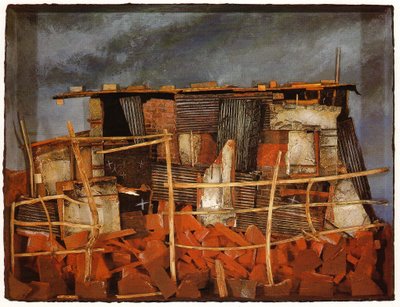
Russell Mills
“Well, what do you think, will psychiatry help ?”
Meridians One was the first Touch tape I bought, can’t remember where, possibly Rough Trade or the ICA, but it opened up a new landscape to me. Before you listened to anything, the first thing that struck you was the highly individual character of the design, which, in the early days was by Garry Mouat, with photo manipulations by Panni Charrington. It was unlike anything else at the time. It created a very fresh visual identity that really drew me in. Charrington seemed to have a thing about eyes. Disembodied, floating. I had no idea what to expect from the music, recognising only a couple of names in the compilation, such as Graham Lewis and John Foxx, but I was hungry for new stuff, and soaked up whatever I thought looked interesting.
And sure enough, this was a fascinating bunch of musicians and composers: AC Marias, aka Angela Conway, friend of Graham Lewis and Bruce Gilbert, who I was to later hear on a Dome LP, Simon Fisher Turner, a greatly underrated composer who went on to create beautiful scores for many Derek Jarman films, Current 93, Test Dept., Ludus, and others who’ve since dropped off the radar, or changed aliases. Previously, the work of Brian Eno and Jon Hassell had introduced me to the notion of psychoacoustic space — the idea of using recording technology to create imaginary spaces and atmospheres: the suggestive power of sound. This lot expanded the parameters a good deal further.
It was uncharted terrain.
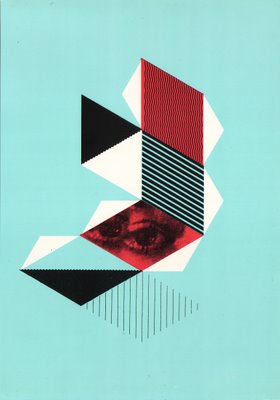
Garry Mouat
“It would have been impossible had you not been dead”
What unfolded was a Ballardian interzone of ritual sounds and atmospheres, sticky with slap delays, gated reverbs and ping pong echoes. It was like going upriver to meet Kurtz. Featuring a lot of electronically processed sounds and percussion, the tracks were bracketed with intriguing media clips, field recordings and loops. This created a certain kind of skewed continuity to the proceedings. These were soundtracks that created their own films in your head. Ear theatre. It was a new world to me, difficult and challenging at times, but engaging enough to go the distance with.
This was a space I wanted to inhabit. The Borroughsian cut-up of information, the interaction of media - written, graphic and sonic - created intriguing synergies, ideas in flux, capricious, unstable. Co-ordinates were thrown down for you to navigate the terrain. There was layering, overlap, jump-cuts, odd juxtapositions. It was rich and filmic. Eisenstien meets Brakhage. Dada for the 80s. Alien broadcasts. It wasn't a conventional narrative. The sense of the material lay in the way you chose to order it. It was heuristic. Touch's modus operandi always encouraged further investigation.
Allied to my interest in punk's DIY approach and spirit of experimentation, this was my introduction to the more obscure areas of sonic exploration – the industrial scene protagonists like Einstürzende Nuebauten, Test Dept., z’ev, Dome, Bow Gamelan. This really ignited my own explorations into sound and related visual experiments. Sound as sculptural element. Non-musical soundsources. New mental maps were being charted with this music - outer limits, nameless zones. This fed into my visual work with an exploration of the suspended time zones of derelict spaces that Dublin was once so full of. All hoovered up now of course, in a squeaky clean future of chequebook modernism* and Euro ennui.
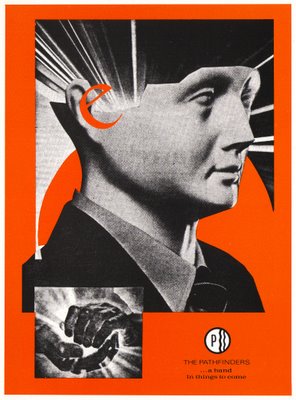
Malcolm Garrett & Roger Cleghorn
“And I don’t want any escape routes out of that, I want to keep looking at the human”
I caught up on the previous two tapes (Feature Mist & Touch 33) and other releases followed, some in beautifully designed plastic wallets, with looseleaf artwork and writing, some in boxes that were like tiny videotape cases. I always found their visual side an utterly beguiling parallel to the music. It was a time when some others took a similarly creative approach to design - the likes of Greater Than One, Test Dept., and :zoviet*france: (who really pushed the boat out with LPs in foil, string-bound hardboard and roofing felt). It was a golden era.
It had a fairly significant effect on my approach to working with images in art school. It inspired a kind of lateral thinking. I was hardwired to my walkman most of the time, and spent long hours painstakingly designing not just elaborate tape covers for my own collection, but artwork for the cassette shells aswell. It was completely obsessive. The forensic scrutiny of scalpel and Rapidograph pen. It was also a time when I didn’t fully grasp the long term value of these releases: Feature Mist had a very long New Order track that I hated so much I taped over it, using a tape counter to fit the material recorded over it and not lose what came after it. It never occurred to me to copy the entire tape and leave out the offending track.


Nocturnal Emissions: Drowning In A Sea Of Bliss


Narodna: Music from Albania, Croatia, Macedonia & Serbia
There was also a third strand: high quality creative and critical writing on contemporary culture from the likes of Jon Savage, Jamie Reid, Raoul Vaneigem, Simon Frith, Paul Buck, and Griel Marcus, amongst others. One double release, Magnetic North, was quite ambitious. A C90 featuring Gilbert & George, Biting Tongues, Nocturnal Emissions, Einstürzende Neubauten and Camberwell Now, amongst many others, was accompanied by a lavishly designed magazine (featuring different paper stocks) on the theme of ritual and its relationship with contemporary society. There was a particularly prescient essay by Jon Savage on the nature of mass media rituals and the cult of celebrity, which still strikes a chord today:
"The celebrity is a person tuned into an abstract. Their status has little to do with their achievement (or lack of it) but everything to do with their ability to fit in with the demands of the new mass media ritual. This involves availability, accessibility, pliability and respectability - 'shocking' people are carefully dropped in to add spice or to populate ghettos. As they parade across the surface of the electronic media, celebrities become symbols (and, occasionally, victims), members of the televisual elite encouraging emulation and aspiration - the modern call to prayer."
Sums up 'reality' TV...
Touch's editorial outlines their approach:
“With Touch, we have endeavored not to force thoughts to our readership on each magazine’s overall content, preferring to leave as opened and still detailed a collection of ideas as possible – even though, in the real sense everything through to the choice of colours is “editorial”. With this double edition “Ritual” we paint a large subject whose omissions determine some dispensations; parts of these gaps are suggested by quotations elsewhere, bearing in mind EM Forster’s words that signposts should not be confused with the destination itself...”
This is what differentiated Touch from other labels. Though they were no mere 'label' – they saw themselves as “audio-visual publishers”, doing limited edtions for a specialist audience. They could also be regarded as curators, tapping into the culture with a keen eye and ear for fresh and innovative work. Exhibitions for speakers and coffee table. Or headphones and travel. Their passion for the various projects was infectious. They mostly worked at a loss in the early years - their approach to publishing would have been viewed by others in the trade as commercial suicide. Not that they cared. These genuinely interactive documents were produced as a labour of love, with a forensic precision and attention to detail when it came to editing and design. To me, this made the product deeply satisfying, and inspiring. Touch's choice of presentation and dissemination was an implictly political act, a subtle subversion of accepted modes. It was an oppositional and healthy alternative to the mainstream, and the indie market, which itself was to become another mainstream, a different behemoth.
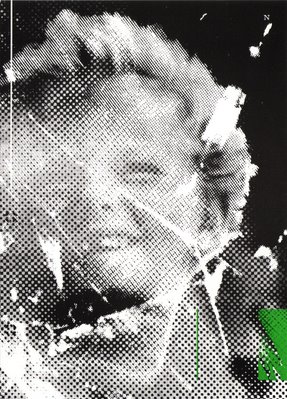
Neville Brody & Chris Moretone
“And lastly, we’ve got six divided by two – now that means six divided into two equal amounts, and I’ll do that”
Touch were consistently interesting and took risks. Lack of familiarity was no barrier to trying something out. On the contrary. The material was highly eclectic and featured a fair sprinkling of excellent ethnographic recordings which enhanced the sense of richness and diversity in music making. Touch definitely seeded my interest in this area. The world was a fascinating place if you listened: from street sounds to Gamelan orchestras to contemporary composition and noise music, all had parity of interest - Touch’s approach was panglobal, pantheistic, polymorphous and pluralist. I had started reading John Cage’s writings at this time, and his dictum that all sound could be music found sympathetic resonance in Touch tapes.
The walkman was in its early days and these tapes took you places that formed a fascinating overlay to the humdrum of the daily commute. Acoustic psychogeography. Travel whilst traveling. Or stay at home and be an armchair traveler. It also got me into field recording. I remember Mike telling me that their Indonesian-based travelogue Islands In-Between was recorded on a walkman. I was amazed. In my innocence, I had visions of someone hoofing something as unwieldy as a Nagra around. That particular summer (1986) I picked up a second hand recording walkman, and a whole new world opened up to me, one which could be framed simply with the discreet use of microphone and headphones. Working with a clip mic was especially handy as you avoided the nerd factor of standing around pointing a mic at things... Nowadays binaural mics make it even more discreet.
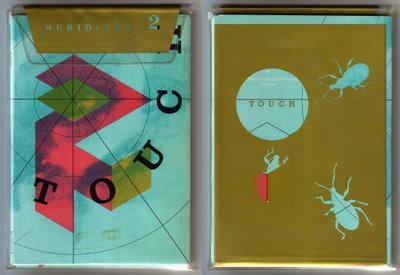
Meridians 2
One release, Travel, actually covered the theme, with artwork and writing on stock that folded like maps. Alongside David Toop’s recordings of Yanamamo shamans were Balinese cremation rituals, South American zampona players, Cologne church bells, 3 Mustaphas 3, General Strike (Toop & Beresford), rain on galvanized metal, London Underground recordings, Jon Keliehor’s Percussion Research Ensemble, and Eithne Ni Bhroanain, shortly before she anglicised her name to Enya and disappeared into a new age mist. Touch went on to champion particular non Western musicians and groups from places like Indonesia, Egypt, Africa, Albania, Croatia, Macedonia and Serbia. They also made features of some essential work coming out of the underground – in particular The Hafler Trio and Strafe Für Rebellion, who, between them used a combination of field recordings, electronics, prepared instruments and obtuse texts that had a profound effect on my approach to sound. Praise be to Touch for having the vision to support these people…

Mooie Charrington
"Cool in the north, and very warm in the south"
Recently I transferred most of these tapes to hard disc and made CDs of them. I hadn’t listened to these tapes for years (I don’t listen to tapes anymore), and it really brought me back, entering into them again. It was interesting how fresh a lot of it still sounded, how well they’d aged. Interesting too how much I noticed the artifact of tape hiss. At a time when surface noise has ceased to be an issue, having grown so used to digital purity, this phenomenon seemed curiously heightened (especially when I was topping and tailing the tracks). It reminded me of the vicissitudes of analogue tape, and how precious items could blighted by dropout and wow and flutter.
Though they dropped the cross-media presentation of old to concentrate more on the music, Touch continue to bring the work of quality sound artists, composers and musicians to the attention of a wider public, and still continue to produce beautifully designed CDs with the visually arresting photography of Jon Wozencroft. They celebrated their 25th anniversary last year, a long time for a business of this nature to last. Well, happy birthday lads ! Here’s to the next 25 years… ;-)
*Iain Sinclair: Downriver (Granta 1991)
Apart from Nocturnal Emissions and Narodna, the artwork pictured above appeared originally as part of Meridians 2
For more artwork and liner info, go to Touch, click on Touch 25 and scroll down to the bottom of the page where it says "Early cassette culture"
